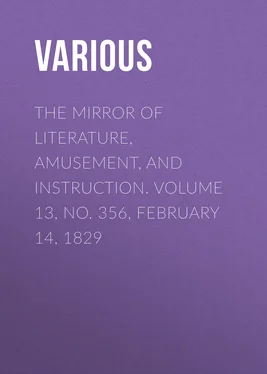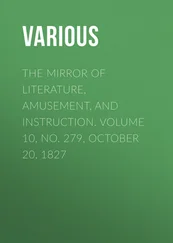Various - The Mirror of Literature, Amusement, and Instruction. Volume 13, No. 356, February 14, 1829
Здесь есть возможность читать онлайн «Various - The Mirror of Literature, Amusement, and Instruction. Volume 13, No. 356, February 14, 1829» — ознакомительный отрывок электронной книги совершенно бесплатно, а после прочтения отрывка купить полную версию. В некоторых случаях можно слушать аудио, скачать через торрент в формате fb2 и присутствует краткое содержание. Жанр: foreign_antique, periodic, Развлечения, foreign_edu, на английском языке. Описание произведения, (предисловие) а так же отзывы посетителей доступны на портале библиотеки ЛибКат.
- Название:The Mirror of Literature, Amusement, and Instruction. Volume 13, No. 356, February 14, 1829
- Автор:
- Жанр:
- Год:неизвестен
- ISBN:нет данных
- Рейтинг книги:3 / 5. Голосов: 1
-
Избранное:Добавить в избранное
- Отзывы:
-
Ваша оценка:
- 60
- 1
- 2
- 3
- 4
- 5
The Mirror of Literature, Amusement, and Instruction. Volume 13, No. 356, February 14, 1829: краткое содержание, описание и аннотация
Предлагаем к чтению аннотацию, описание, краткое содержание или предисловие (зависит от того, что написал сам автор книги «The Mirror of Literature, Amusement, and Instruction. Volume 13, No. 356, February 14, 1829»). Если вы не нашли необходимую информацию о книге — напишите в комментариях, мы постараемся отыскать её.
The Mirror of Literature, Amusement, and Instruction. Volume 13, No. 356, February 14, 1829 — читать онлайн ознакомительный отрывок
Ниже представлен текст книги, разбитый по страницам. Система сохранения места последней прочитанной страницы, позволяет с удобством читать онлайн бесплатно книгу «The Mirror of Literature, Amusement, and Instruction. Volume 13, No. 356, February 14, 1829», без необходимости каждый раз заново искать на чём Вы остановились. Поставьте закладку, и сможете в любой момент перейти на страницу, на которой закончили чтение.
Интервал:
Закладка:
2 2 These stalls or seats which were formed of oak, and of the most elaborate workmanship, occupied the side, and western end of the choir: they were surmounted by canopies, supported by slender pillars, rising from the arms, each being furnished with a movable misericordia.together with their richly carved canopies, have likewise perished. The altar table, which stood at the eastern end of the choir, on a raised pavement, ascended by a flight of fifteen steps, is likewise consumed, and the communion plate melted. The beautiful stone screen, which separated the Lady's Chapel from the altar, has not suffered so materially as was at first imagined. This elegant specimen of ancient sculpture is divided into eight pointed arches, and elaborately ornamented with tracery work: the lights were filled with plate glass, through which a fine view of the great eastern window was obtained; some pieces of which still remain uninjured.
Such are the principal parts of the cathedral which have suffered. The books, cushions, and other movable effects, from the northern side of the choir, were fortunately rescued, together with the brazen eagle, from which the prayers were read. The wills, and other valuable documents, were also preserved.
The choir, the destruction of which we have just related, was built by John de Thoresby, a prelate, raised to the archiepiscopal chair in 1532. On this building he expended the then enormous sum of one thousand eight hundred and ten pounds out of his own private purse. The first stone was laid on the 29th of July, 1361; but the founder died before its completion, as is evident from the arms of several of his successors in various parts of the building, particularly those of Scrope and Bowet, the latter of whom was not created archbishop until the year 1405. It was constructed in a more florid style of architecture than the rest of the fabric. The roof, higher by some feet than that of the nave, was more richly ornamented, an elegant kind of festoon work descending from the capitals of the pillars, which separated the middle from the side aisles; from these columns sprung the vaulted roof, the ribs of which crossed each other in angular compartments. The magnificent window, the admiration of all beholders, occupies nearly the whole space of the eastern end of the choir; it is divided by two large mullions into three principal divisions, which are again subdivided into three lights; the upper part from the springing of the arches are also separated into various compartments. It contains nearly two hundred subjects, principally scriptural. The painting of this window was executed about the year 1405, at the expense of the dean and chapter, by John Thornton, a glazier, of Coventry, who, by his contract, was engaged to finish it within three years, and to receive four shillings per week for his work; he was also to have one hundred shillings besides; and also ten pounds more if he did his work well. 3 3 Vide Drake's Eboracum, p. 527.
On the exterior of the choir, immediately over the window, is the effigy of John de Thoresby, mitred and robed, and sitting in his archiepiscopal chair, his right hand pointing to the window, and in his left holding the model of a church. At the base of the window are the heads of Christ and the Apostles, with that of some sovereign, supposed to be Edward III.
We will now bring this article to a close, by quoting the words of Æneas Sylvius, afterwards Pope Pius II., in praise of York Cathedral. He says, "It is famous all over the world for its magnificence and workmanship, but especially for a fine lightsome chapel, with shining walls, and small, thin-waisted pillars, quite round." 4 4 We thank our intelligent antiquarian correspondent for this article, which, he will perceive appears somewhat, abridged, as we are unable to spare room for further details.
THE VINE
On the day of their creation, the trees boasted one to another, of their excellence. "Me, the Lord planted!" said the lofty cedar;—"strength, fragrance, and longevity, he bestowed on me."
"Jehovah fashioned me to be a blessing," said the shadowy palm; "utility and beauty he united in my form." The apple-tree, said, "Like a bridegroom among youths, I glow in my beauty amidst the trees of the grove!" The myrtle, said, "Like the rose among briars, so am I amidst the other shrubs." Thus all boasted;—the olive and the fig-tree—and even the fir.
The vine, alone, drooped silent to the ground! "To me," thought he, "every thing seems to have been refused;—I have neither stem—nor branches—nor flowers,—but such as I am , I will hope and wait." The vine bent down its shoots, and wept!
Not long had the vine to wait; for, behold, the divinity of earth, man, drew nigh; he saw the feeble, helpless, plant trailing its honours along the soil:—in pity, he lifted up the recumbent shoots, and twined the feeble plant around his own bower.
Now the winds played with its leaves and tendrils; and the warmth of the sun began to empurple its hard green grapes, and to prepare within them a sweet and delicious juice.
Decked with its rich clusters, the vine leaned towards its master, who tasted its refreshing fruit and juicy beverage; and he named the vine, his friend and favourite.
Despair not, ye forsaken; bear—be patient,—and strive.
From the insignificant reed flows the sweetest of juices;—from the bending vine springs the most delightful drink of the earth.
THE SKETCH-BOOK
THE BATTLE OF NAVARINO.—BY AN OFFICER ENGAGED.
We had been cruizing off the coast of the Morea, for the protection of trading vessels, and to watch the motions of the numerous Greek pirates infesting the narrow seas and adjacent islands. For fourteen months we had been thus actively employed, when the arrival of the Albion and Genoa, from Lisbon, hinted to us, that some coercive measures were about to be used against the Turks, to cause them to discontinue the exterminating war they carried on against the Greeks, and to evacuate the country pursuant to the terms of the treaty of July, 1827. The prospect of a collision with the Turkish fleet appeared to be very agreeable to the ship's crew, as they had got a little tired of their long confinement on board, and anxiously looked for a speedy return to Malta to get ashore, which they had not been able to do for upwards of a year. We again proceeded on our protecting duty, and parted company with the admiral in the Asia. In about six weeks we returned, and found that many other British vessels had joined the Asia, whilst the squadrons of France and Russia added to the number of the fleet, which altogether presented an imposing attitude.
The Turkish and Egyptian fleets had arrived from the unsuccessful attempt in the Gulf of Patras some time before, and lay off the Bay of Navarino, before they finally entered and took up a position within the harbour. While the Ottoman fleet lay off the bay, the Turkish troops were said to have committed many unjustifiable outrages on the defenceless inhabitants of the country adjacent to Navarino; information of these oppressive acts was conveyed to the British admiral, and, it is believed, formed the grounds of a strong remonstrance on his part, addressed to the Turkish commanders, which hastened the collision between the two armaments. These facts were generally known throughout the fleet, and a " row " was eagerly expected.
Читать дальшеИнтервал:
Закладка:
Похожие книги на «The Mirror of Literature, Amusement, and Instruction. Volume 13, No. 356, February 14, 1829»
Представляем Вашему вниманию похожие книги на «The Mirror of Literature, Amusement, and Instruction. Volume 13, No. 356, February 14, 1829» списком для выбора. Мы отобрали схожую по названию и смыслу литературу в надежде предоставить читателям больше вариантов отыскать новые, интересные, ещё непрочитанные произведения.
Обсуждение, отзывы о книге «The Mirror of Literature, Amusement, and Instruction. Volume 13, No. 356, February 14, 1829» и просто собственные мнения читателей. Оставьте ваши комментарии, напишите, что Вы думаете о произведении, его смысле или главных героях. Укажите что конкретно понравилось, а что нет, и почему Вы так считаете.












